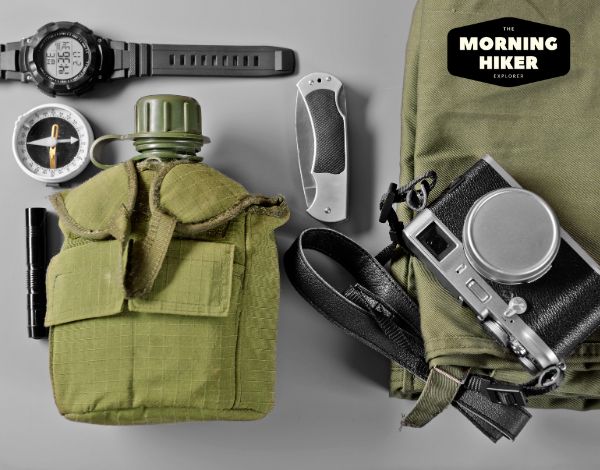Stay safe on your next hike with these must-have essentials. Adventure awaits, but don’t forget to put safety first! Click to read more.”
This post contains some affiliate links to products that I use and love. If you click through and make a purchase, I’ll earn a commission, at no additional cost to you. Read my full disclosure here.
When it comes to hiking, ensuring your safety should always be your top priority. Exploring the great outdoors can be an exhilarating experience, but it’s crucial to be prepared and equipped with the right gear.
In this comprehensive guide, we will delve into the essential equipment needed for hiking, ensuring that you have a memorable and safe adventure.
In This Article
Hiking Footwear: The Foundation of Your Journey
1. Hiking Boots: Sturdy Support for Your Feet
Investing in a pair of high-quality hiking boots is essential for any outdoor enthusiast. Look for boots that offer ankle support, waterproofing, and excellent traction. A snug fit with proper arch support and cushioning will keep your feet comfortable throughout your hike.
2. Hiking Socks: Keeping Your Feet Dry and Blister-Free
Don’t underestimate the importance of good socks when it comes to hiking. Opt for moisture-wicking, padded socks that provide cushioning and prevent blisters. Merino wool or synthetic blends are popular choices due to their moisture management properties.
Navigation Tools: Finding Your Way Safely
3. Map and Compass: Traditional Navigation Tools
While smartphones and GPS devices have become increasingly popular, carrying a map and compass should be an integral part of your hiking gear. Technology can fail, but a reliable map and compass will always guide you back on track.
4. GPS Device: Modern Navigation Convenience
In addition to the traditional tools, consider carrying a GPS device as a backup. These devices provide accurate positioning and can help you track your route, mark waypoints, and even share your location with others. Remember to carry spare batteries or a power bank to ensure your device stays functional.
Safety Essentials: Be Prepared for the Unexpected
5. First Aid Kit: Handling Minor Injuries
Accidents can happen even on well-planned hikes. A compact first aid kit containing essentials like bandages, antiseptic wipes, pain relievers, and adhesive tape is a must. Familiarize yourself with basic first aid procedures and carry a manual for reference.
6. Emergency Shelter: Protection from the Elements
Weather conditions can change rapidly, and unexpected emergencies may require you to spend an unplanned night outdoors. Lightweight emergency shelters such as bivy sacks or emergency blankets provide vital protection from rain, wind, and cold temperatures.
7. Headlamp or Flashlight: Illumination for Nighttime
Whether you plan to hike during the day or venture into overnight trips, a reliable headlamp or flashlight is indispensable. Opt for models with adjustable brightness settings and long battery life to navigate in low-light conditions.
8. Whistle: Signaling for Help
A small yet powerful signaling tool, a whistle can be a lifesaver during emergencies. Its sound can travel long distances, alerting others to your location. Attach a whistle to your backpack or carry it on a lanyard for quick access.
9. Multi-Tool: Versatility in Your Pocket
A multi-tool combines several essential tools into one compact device. Look for features like a knife, pliers, screwdriver, and scissors. This versatile tool can assist in various tasks, from gear repairs to food preparation.
Hydration and Nutrition: Fueling Your Adventure
10. Water Bottles or Hydration Bladder: Staying Hydrated
Proper hydration is crucial while hiking. Carry reusable water bottles or use a hydration bladder that fits into your backpack. Aim to drink at least 2 liters of water per day, adjusting based on the intensity and duration of your hike.
11. Trail Snacks: Nourishment on the Go
Pack lightweight, energy-rich snacks to keep your energy levels up during your hike. Trail mix, energy bars, dried fruit, and nuts are popular choices. Consider your nutritional needs and choose snacks that provide a balance of carbohydrates, protein, and healthy fats.
Clothing and Protection: Adapting to the Elements
12. Layered Clothing: Adapting to Weather Changes
Wearing appropriate clothing is essential to stay comfortable and protected on the trail. Dress in layers, starting with a moisture-wicking base layer, insulating mid-layer, and a waterproof and windproof outer layer. Opt for breathable and quick-drying materials.
13. Sun Protection: Shielding Yourself from Harmful Rays
When spending time outdoors, protecting your skin and eyes from the sun’s harmful UV rays is crucial. Wear a broad-brimmed hat, UV-protective sunglasses, and apply sunscreen with a high SPF rating to exposed areas of your skin.
14. Insect Repellent: Warding Off Unwanted Visitors
Depending on the hiking destination, insects can pose a nuisance and even carry diseases. Apply insect repellent to exposed skin and clothing to keep mosquitoes, ticks, and other bugs at bay. Consider wearing lightweight, long-sleeved shirts and pants for added protection.
What’s Next?
Embarking on a hiking adventure is an incredible way to connect with nature and challenge yourself physically. By ensuring you have the essential equipment mentioned in this guide, you’ll be well-prepared to tackle any hiking trail. Remember, safety should always be your priority, so take the time to research, plan, and acquire the gear necessary for a successful and enjoyable journey.



We are participants in the Amazon Services LLC Associates Program, an affiliate advertising program designed to provide a means for sites to earn advertising fees by advertising and linking to Amazon.com